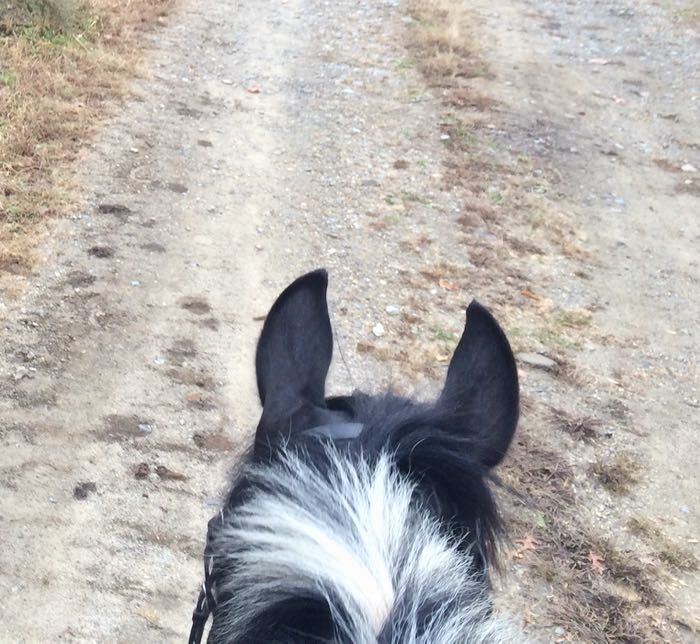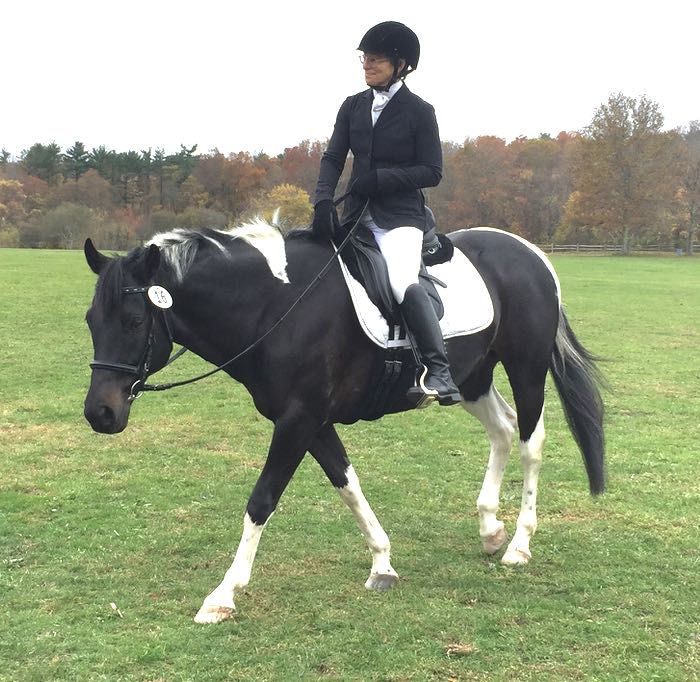Ears are for listening. The horse’s ears swivel in response to sounds both near and far, so if you pay attention to the ears, your world opens up. My horse hears far better than I do, so by watching his ears I see things that I would otherwise not have noticed. I recently followed Tonka’s ears and saw a person far off the trail in the woods. Because Tonka let me know that there was someone there, as the hiker emerged from the trees later, neither of us were startled (although the hiker was!)

Ears also communicate a horse’s mood. Here is Tonka, relaxed after a warm up and ready to enter the dressage ring.

Sometimes ears can be an early warning system for the rider. Horses are large, and to us humans, mythic animals. We think of them in dramatic poses – galloping across plains, rearing up, neighing loudly. Yet in their personal lives horses prefer to communicate with subtlety. They never yell if they can get their point across in a nuanced way. Unfortunately for our horses, we’re often oblivious to what they’re saying until they have to escalate to dangerous behavior. I’ve written about how to read a horse’s ear position here.
Tonka has only bucked a few times while I’m on his back, but they were doozies. (It felt rather like this.) I’m an experienced enough rider to sense when something is about to happen – the ears pin back, the horse’s body bunches, and then his legs do a sproingy step right before the imminent eruption. That said, those warning signs can take only three seconds which is not enough time to convince the horse to do something other than leap with all four off the ground. (It’s enough, though, for me to sit tight and not come off!) A big buck can seem like out of the blue behavior, but it’s not. There are always antecedents to the acrobatics. The first buck that Tonka threw happened when we were behind another horse on a trail. Tonka likes to amble and the horse in front was moving along at a faster clip. Tonka would lag and then trot to catch up. I didn’t want him to do that, and in an attempt to get a more energetic walk, I held him back from trotting. Tonka was annoyed and he let me know it.
At the time I did notice the pinned ears and the tensing body. But it took another buck before I noticed an odd warning sign. Right before he let loose, Tonka twitched his head and flicked his ears as if there were bees buzzing around him. Nothing frantic, just a head shake. Since then, I’ve seen Tonka do this a dozen times, and in each instance it’s a clear tell that he’s overwhelmed. That ear flick is the equivalent of him saying, Terry, I’ve had it. This is too much!
Along with trail riding, I also do dressage. In dressage competitions, you ride patterns in a rectangular ring. Dressage builds up to balanced, cadenced, seemingly floating movement. This can (and should) take years. It’s like a figure skater going from wobbling on a blade to leaping double axels. We’re in the early stages, but we’ve recently had a breakthrough to the next level. Tonka is now able to push off more from his hindquarters and lift his forehand as he goes. He’s getting lots of rewards (mints and praise) for his hard work, and he seems to enjoy it – he’s going with a relaxed back and happy ears. But yesterday, as he gathered himself to go into this frame, I saw that head shake. If it was fly season I might have written it off as something buzzing about, but there are no annoying insects in March. The work was irritating him. The rest of Tonka’s body was doing as I asked, but I saw the tell. Good training builds on successes, it doesn’t push past a physical or mental limit and then punish failure. I want cooperative, enthusiastic engagement, not forced behavior. So, I respect what those ears have to say.
I don’t know what at that moment bothered Tonka. Last week the horses got their spring vaccines. Maybe he was sore. Maybe there was a twinge in his hocks. Maybe the movement felt like work and not joy. Whatever. I took a deep breath, relaxed, and ratcheted back to a basic, swinging. long-necked trot. Sometimes the slower you go, the faster you get there.

Here is Tonka later that day. All of the horses “had the wind under their tails” and were snorting it up around the paddocks. He’s carrying himself in a way that we’re working towards under saddle. Even at liberty, this is physically demanding and he only sustains it for a dozen strides.


Hi Terry,
I was following the hen blog an from there this one anyway. I have started a friends horse who was broken in with 4 and efter that hardly even handled for nearlt eight years. He is very cuddly and fri ndly, but mega green. He has to learn the basics again. He did not want to lift his feet, front was sort of ok, bakc he pulled up and away. I did not want to push him as I am in no,hurrry and do not want to mess him up. So it happens I watched you video about Tonka learning to stop correctly and as the horse I am looking after is very food driven I started an experiment, I had tiny pieces of carrot in my pocket and as soon as he gently lifted and held his back hoofs even just for a second I gave hima a “good boy” which I always use when he is doing the right thing and instantly gave him a piece of carrot. What shall I say the second next time I attempted the back leg lift, he lifted them gently and I could hold them for a while… No pulling whatsoever!
Another problem he had was massive headshaking. Afte thinking about it for a while and remembering he has a tiny wolf tooth, I thought the bit might be the problem, so I tried the soft approach and just put the bit in much lower., instead of putting a martingale or similar in n as fri nds suggested… You know what.. lower bit resulted in absolutely no head shaking instantly.
I have learned from your page to take a mor gentle approach and looking inot things from the horses view and it is a wonderful way to work wwoth your horse in a friendship based way! Thanks Terry
This note makes my day. Well done, Jutta! You are applying what I call the “power of intent.” You assume that the horse means well and will do the right thing if only he understands what you are asking for and is physically able. Rewarding the moment he starts to do the desired behavior sets him on the path so that he can complete the task. Being aware and adjusting for what might be painful to him, or what he might be fearful of, will set you both up to work together as a team. He’s a very, very lucky horse to have you in his life.
Please excuse the horrible spelling typing on the tablet isn’t my strength 😉
Thanks for your kind reply.
Yes I do think I learn a lot from your posts. Just in general I think I really changed my approach to stepping back and having a look from the horses perspective first, although I was always leaning towards the opinion that horses firstly mean well. And the one I am working with at the moment is a very special case because he is such a big sucker for praise (and carrots), just really wants to please, but so extremely green for his age.
Keep blogging so I can keep learning ! And if you ever make it to New Zealand let me know. 😉
One of these years I’d love to get to NZ!